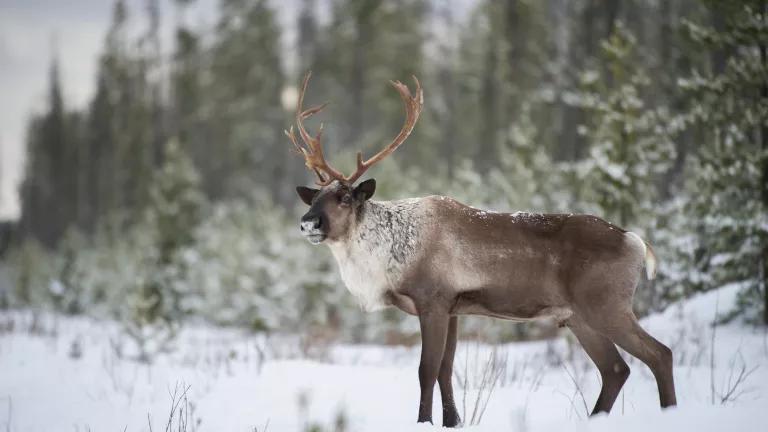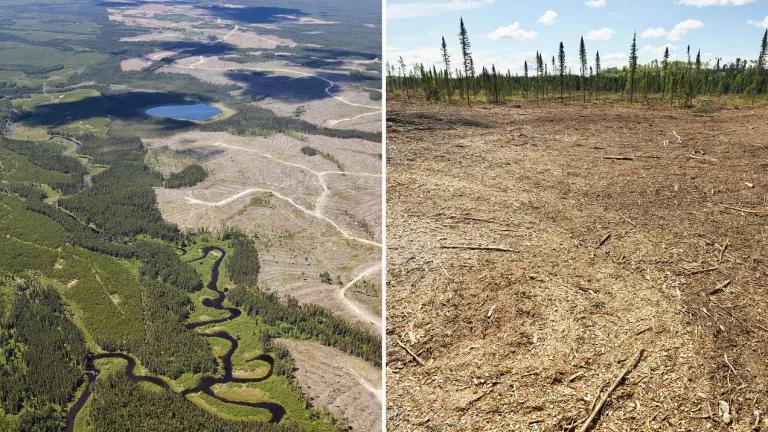Two First Nations Pledge to Save Lake Superior Caribou
The Biigtigong Nishnaabeg and Michipicoten First Nations are raising the alarm over the dwindling population of the southernmost remaining woodland caribou in North America.

All Canada Photos/Alamy
“Our big fear is that they're going to disappear altogether. I keep thinking, What would my grandfather do? What would my great-great-grandfather think if they knew we were allowing them to disappear—that we didn’t do anything?”
Chief Duncan Michano of Biigtigong Nishnaabeg (Pic River First Nation)
Two First Nations—Biigtigong Nishnaabeg and Michipicoten—are raising the alarm for the dwindling Lake Superior caribou, the southernmost remaining woodland caribou in North America. They say their expertise and conservation ethics have been snubbed in a recent effort by the Ontario government to have a management plan for these vulnerable caribou completed by a third party without their knowledge or consent.

Chief Duncan Michano
Biigtigong Nishnaabeg First Nation
Woodland caribou—also known as boreal caribou under Canada’s Species at Risk Act—have been steadily declining and are considered threatened with extinction. Only 14 herds are considered self-sustaining, meaning their populations are steady or increasing, while 37 are at risk of local extinction. Several are hanging on due only to enormous efforts by Indigenous nations. In the late 1800s, caribou populations extended around Lake Superior into Minnesota, Wisconsin, and Michigan. They were also living along the north shores of Lake Huron and Manitoulin Island. Over time, a combination of unregulated hunting and human developments, which removed and negatively altered their habitat, resulted in local extinction and range recession northward. Today, caribou ranges have receded significantly, with more than 60 miles effectively separating the few remaining Lake Superior caribou from northern herds. Now, caribou appear to be gone from the mainland along Lake Superior, and only a small number remain in the recently relocated populations on the Slate Islands and Caribou Island in Lake Superior.
For several years, Biigtigong Nishnaabeg and Michipicoten First Nations, along with dedicated local conservationists, have called on the Ontario government to do more to protect the caribou remaining on the lands and waters of their traditional territories. These First Nations insist that caribou have continued to decline due to successive provincial governments refusing to protect, augment, or salvage any of the Lake Superior caribou when they were in trouble. Nor, they say, has the provincial government put forward sufficient efforts to reduce habitat degradation or restore the original mainland forest to allow caribou to safely re-establish there. Caribou are adapted to older, conifer-dominated forests. When these forests are disturbed, they are often replaced with younger deciduous or mixed deciduous-conifer forests. These altered forests support higher numbers of moose and deer, and with them come increases in predators, which often have severe impacts on caribou numbers. Caribou have fewer young each year than moose and deer, and while moose can use their sheer size and fierce kicking to defend themselves and deer can use their speed to outrun their predators, caribou simply try to move to areas where they are less likely to interact with predators at all.
Even the situation for caribou on normally predator-free islands in Lake Superior is precarious. In the cold winter of 2014, ice formed from the mainland to both Michipicoten Island and the Slate Islands. Wolves reached both of these islands on the ice. By late 2017, only two adult males were left from the previous 100 to 200 caribou on the Slate Islands. This is called functional extirpation because the population cannot rebuild from only one sex. By 2018, all of the estimated 900 to 1000 caribou on Michipicoten Island had been extirpated.
The First Nations don’t blame the wolves; they blame the government officials who they say sat back and watched this unfortunate ecological catastrophe unfold. The Ontario government refused to move off the wolves to help conserve these two anchor populations of Lake Superior caribou. Instead, it set up a study to watch and document the inevitable conclusion. Only at the eleventh hour were a few of the last caribou on Michipicoten Island moved to restart the population on the Slate Islands and establish a backup population on remote Caribou Island.

Map of Lake Superior caribou translocations
Duluth New Tribune, April 5, 2020, reproduced with permission
The end result was that the Lake Superior caribou went from an estimated population of more than 1,100 in 2014 to probably fewer than 30 in 2018—a staggering 97 percent decline. This appears to be the most drastic collapse of caribou that has ever occurred anywhere. But they would have been completely gone now without public and First Nation pressure and assistance with the last-minute relocations to Caribou Island and the Slate Islands, as well as financial support from Michipicoten First Nation, the Weston Foundation, and the Elisabeth Elliot Foundation.
It remains to be seen whether these last-minute rescue efforts will save the Lake Superior caribou in the long term. There is a plan to restore caribou to Michipicoten Island, but the island must be wolf-free and there was still at least one wolf there last summer. The Ontario government will not agree to moving it off to get the caribou back. There are now enough caribou on the Slate Islands and Caribou Island to move to Michipicoten Island. The First Nations have expressed frustration that the Ontario government has also put up obstacles to their participation in this restoration.
Biigtigong Nishnaabeg and Michipicoten First Nations do not want to wait until the next catastrophe for these vulnerable caribou. They want to fully participate in proactive comanagement to restore the Lake Superior caribou now. They first want to get caribou back to Michipicoten Island to re-establish this anchor population. Then they want to start moving caribou back to suitable areas on the mainland. This will also involve a long-term commitment to restore the ecosystem on the mainland toward a condition in which caribou can be self-sustaining again.
“They’re our relatives. Just like we would not harm our aunties and uncles or our brothers and sisters, we wouldn’t harm them knowingly. The government of Ontario has shown time and again their indifference to caribou and this blatant act of disrespect for us and for caribou is a stain on them. It reveals their true lack of sincere conservation ethic for endangered species. Caribou have supported our people for as long as we have been here. They now need our support.”
Chief Patricia Tangie of Michipicoten First Nation
If caribou can be restored to the areas they recently occupied in the northeast part of Lake Superior, this could help to halt the southern range recession of caribou—at least in this part of Canada. More important, it would demonstrate that caribou can be restored in other parts of their range and that their march to extinction can be reversed.

Trail cam footage of two caribou calves and an adult caribou on Caribou Island
To support this vision, Biigtigong Nishnaabeg has written a Caribou Stewardship Plan, which includes 11 interlinked strategies to support the long-term survival of caribou in its territory. However, the First Nation says its efforts are falling on deaf ears with the provincial government. Instead of working with the Biigtigong Nishnaabeg, the provincial government released a bid for consultants to develop a caribou management plan in the First Nation territory with no direction for meaningful involvement of First Nations.
The First Nations’ ask is simple: They want the Ontario government to withdraw the proposal to hire a third-party consultant to develop a caribou conservation plan. Instead, the government should work with the First Nations—immediately—to support caribou recovery and habitat restoration efforts.


